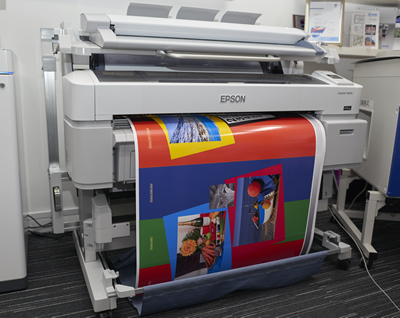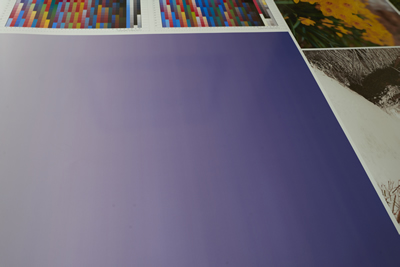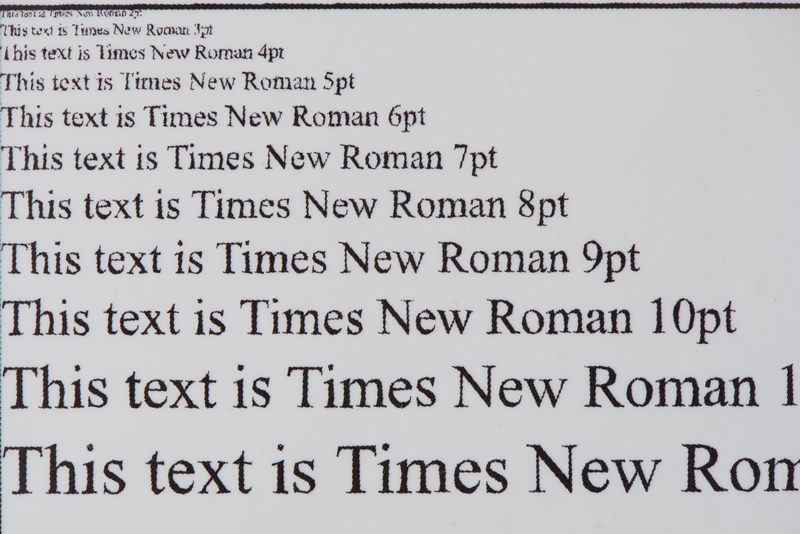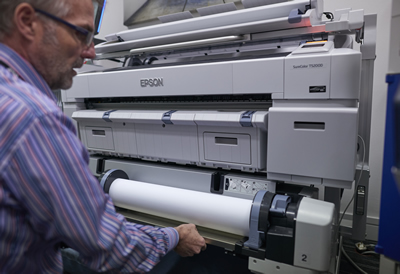Epson’s T-series aqueous ink printers are aimed at the crossover point between technical drawings and graphics. Nessan Cleary tests the printer to see how well it performs.
So far in this test series we've tried a number of solvent and UV-curable printers, and even a couple of latex machines, but this is the first time that we've looked at an aqueous ink printer. The T-series is Epson's latest wide-format offering and aims to bridge the crossover point between CAD and graphics. As such the emphasis is on value for money rather than image quality, though it's got some nice features.
There are three models altogether - the 24ins T3200, the 36ins T5200 and 44ins T7200. The prices start from £1,974. The smallest takes just one roll but the two larger models have options to load two  rolls at once and can also be configured with a 36ins scanner. There's a further option for a 320GB hard drive - you have to have this to use the scanner - and for a PostScript hardware Rip. There's a printer driver for both Windows and Mac users. It comes with HDI drivers and supports HPGL and GIS software.
rolls at once and can also be configured with a 36ins scanner. There's a further option for a 320GB hard drive - you have to have this to use the scanner - and for a PostScript hardware Rip. There's a printer driver for both Windows and Mac users. It comes with HDI drivers and supports HPGL and GIS software.
The printer tested here - the 36ins T5200D - was fully loaded with the second media roll holder, scanner, 320GB hard drive and PostScript Rip. This costs £7,525 plus VAT.
Martin Johns, business manager for professional graphics at Epson, says that its popular with corporate customers: “They use it as a print resource for, technical drawings, posters and signage.” He says it’s also suitable for indoor signage and low-end photography.
These are amongst the first printers to use Epson's new Precision Core TFP printhead. The Precision Core has a modular architecture, that can be tailored to the needs of each printer. In this case the head has ten channels, with two per colour across five inks. This gives 720 nozzles per colour, with a minimum droplet size of 3.5 picolitres.
That said, it’s a four colour CMYK printer. There are two black inks - photo and matte - for use with different types of paper to ensure it can reproduce fine lines accurately regardless of the media in use. The ink itself is Epson's UltraChrome XD ink, where the XD stands for extra density. It's a water-based ink that’s designed to cope with lightweight matte papers. Thus it can print to coated and uncoated media and can handle recycled papers as well as lightweight media such as tracing paper and newspaper as well as photo paper.
Johns explains: “The majority of people will print to fine paper so we need an ink that will give you the density especially on the blacks so the ink is formulated to print to this kind of paper.” As well as roll-fed media it will also take boards up to 1.3mm thick.
The ink comes in plastic cartridges which can be easily recycled. They are available in 110, 350, and 700 ml sizes, priced at £57, £128 and £240, respectively (including VAT).
It's an easy printer to live with. There's very little maintenance. Johns explains: “The aqueous inks are not very aggressive.” When there's a blocked nozzle it's only necessary to blow ink through the blocked channel, which helps to save ink.
Media loading is also straightforward, with both rolls loading from the front so the machine can live up against a wall with no need to access the back. It can cope with both 2in and 3in cores thanks to  an adjustable holder. The top roll simply drops into place with no messing around. The bottom roll sits on a tray underneath the machine - the whole tray slides forward so that you can rest the roll while loading. It should just be a matter of feeding the media into the machine until a sensor grabs it but this can be a little fiddly. The machine switches automatically between the media rolls as needed.
an adjustable holder. The top roll simply drops into place with no messing around. The bottom roll sits on a tray underneath the machine - the whole tray slides forward so that you can rest the roll while loading. It should just be a matter of feeding the media into the machine until a sensor grabs it but this can be a little fiddly. The machine switches automatically between the media rolls as needed.
There’s an optional 36in wide scanner which converts the printer into a large-format multifunctional device. It has 600dpi resolution and can scan 8.4cm per second – Epson claims that it can scan and print an A1 sheet in around 39 seconds and it was certainly able to reproduce a page from a newspaper quickly and accurately. The scanner also takes boards up to 1.3mm thick. It can also scan documents direct to folder or to email.
The printer driver can be used to drive multiple printers from a centralized computer. The hard drive can be used to store jobs so it’s easy to reprint them. It also includes a tool that can tell you how much ink and media you've used - if you enter the prices then it tells you the cost of each job based on consumables use. You can export this to a CSV file to make a spreadsheet.
On test
Our standard test involves printing out two A0-sized test charts, once at the highest resolution to test the image quality the printer can produce, and once at a typical production speed to gauge the likely productivity you can expect from this machine. One chart consists mainly of solid Pantones, while the other is mainly a selection of photographs.
For this test, we used an Epson glossy paper, which limited the options available. So for the image test we used the Quality setting with 1440 x 1440dpi, with uni-directional printing. For the productivity test we used the Speed setting with 720 x 1440dpi bi-directional printing. Bi-directional printing is faster as the printer is putting ink down on both passes but it’s harder for the printer to place those dots accurately and any misaligned dots will lead to lower image quality.
The Quality setting took 17.21 minutes for the photographic chart, and 17.31 minutes for the Pantone chart. The Speed setting was considerably faster, taking 8.15 minutes for the photographic chart and 8.26 minutes for the Pantone chart. However the faster setting produced very similar images to the Quality setting, which would be quite sellable for many applications. There is a very slight loss in definition, which wouldn’t be noticeable from a normal viewing distance.
There is a noticeable issue with fine banding lines in some of the solids though this is less apparent from a normal viewing distance. Curiously, the banding is much worse on the higher quality prints  than with the faster ones.
than with the faster ones.
Also, the colours are very saturated, which has produced some quite pleasing images though the colours do not always appear to be strictly accurate. Thus the yellow tones in the daffodils photograph are really very yellow. That said, the solid Pantone panels do appear to be accurately reproduced when compared against a Pantone chart.
There was little difference in the ink usage between all the prints, with the photographic chart using 10.5ml for the quality setting and 10.13ml at Speed. The Pantone chart used 14.26ml for Quality and 14.18 for the Speed setting.
However, Johns points out that where the machine really shines is with cheaper plain papers. So we printed one of our test charts onto plain paper, albeit shrunk down to fit on a 24ins roll, which took just 35.41 seconds.
Conclusion
Our tests are geared towards the graphics end of the market, whereas this printer really excels at the corporate level, where it can produce good quality prints on cheaper, uncoated media at high speeds. As such, it should find a welcome home in many corporate printrooms. It may also find a home with many designers looking for a multi functional device. The aqueous inks do deliver an added bite that is lacking from most solvent and UV prints and the image quality is good enough to allow many bureaux currently catering to the technical drawing market to branch out into the graphics sector, though I think that the colour accuracy is a little too lax for most photographers.


